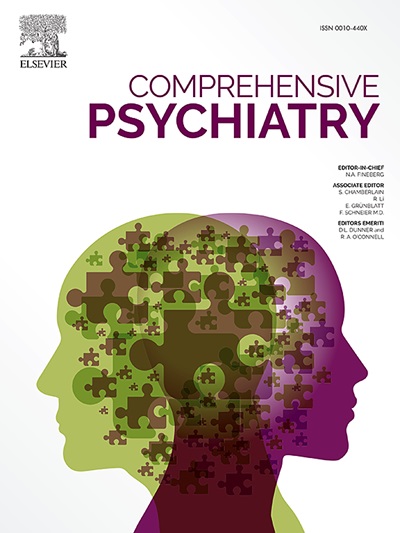囤积或不囤积购买的物品——这有关系吗?强迫性购物障碍的临床横断面研究
IF 4.2
2区 医学
Q1 PSYCHIATRY
引用次数: 0
摘要
背景:对强迫性购物障碍(CBSD)患者的研究表明,共病囤积障碍(HD)与更严重的CBSD有关。本研究调查了一名患有CBSD的临床样本,通过临床访谈确定了HD的患病率,探讨了囤积是否指消费品和/或非购买的免费物品,并比较了(HD+)和非(HD-)共病HD患者在物质主义、冲动、一般精神病理、CBSD和HD症状方面的差异。此外,在总样本中探讨CBSD症状与其他研究变量之间的关系。方法对81例患者进行临床访谈,填写病理购买量表(PBS)、德国储蓄量表(GSI-R)、物质主义量表、冲动量表、抑郁量表和焦虑量表。结果17例患者共患HD,其中82%的患者以囤积物品为主。HD+组在杂波和难以丢弃GSI-R分量表上得分高于HD-组,但在过度获取GSI-R分量表和PBS上得分低于HD-组。在物质主义、冲动和一般精神病理方面没有组间差异。总样本中PBS与GSI-R之间的相关性是由PBS与过度获取GSI-R分量表之间的高度相关性驱动的。PBS/GSI-R过度习得得分越高,物质主义程度越高,精神病理程度越高。结论囤货主要与购买消费品有关,与CBSD症状严重程度无关。在CBSD的背景下,进一步调查囤积的具体情况是必要的。本文章由计算机程序翻译,如有差异,请以英文原文为准。
To hoard or not to hoard purchased items - does it matter? A clinical cross-sectional study on compulsive buying-shopping disorder
Background
Research with individuals with compulsive buying-shopping disorder (CBSD) indicated that comorbid hoarding disorder (HD), as determined by questionnaire cutoffs, is associated with more severe CBSD. This study investigated a clinical sample with CBSD and determined the prevalence of HD by clinical interview, explored whether hoarding refers to consumer goods and/or non-purchased, free items, and compared patients with (HD+) and without (HD-) comorbid HD regarding materialism, impulsiveness, general psychopathology, CBSD and HD symptoms. Additionally, the relationship between CBSD symptoms and other study variables was explored in the total sample.
Method
All patients (N = 81) underwent a clinical interview and answered the Pathological Buying Screener (PBS), the German Saving Inventory-Revised (GSI-R), and measures for materialism, impulsiveness, depression and anxiety.
Results
Seventeen patients had comorbid HD, of which 82 % hoarded predominantly purchased items. The HD+ group scored higher than the HD- group on the clutter and difficulty discarding GSI-R subscales, but not on the excessive acquisition GSI-R subscale or the PBS. There were no group differences in materialism, impulsiveness, and general psychopathology. The correlation between the PBS and the GSI-R in the total sample was driven by the high correlation between the PBS and the excessive acquisition GSI-R subscale. Higher PBS/GSI-R excessive acquisition scores were related to higher materialism and more psychopathology.
Conclusion
The findings indicate that hoarding in CBSD is mostly related to purchased consumer goods and not associated with a higher symptom severity of CBSD. Further investigation into the specifics of hoarding in the context of CBSD is necessary.
求助全文
通过发布文献求助,成功后即可免费获取论文全文。
去求助
来源期刊

Comprehensive psychiatry
医学-精神病学
CiteScore
12.50
自引率
1.40%
发文量
64
审稿时长
29 days
期刊介绍:
"Comprehensive Psychiatry" is an open access, peer-reviewed journal dedicated to the field of psychiatry and mental health. Its primary mission is to share the latest advancements in knowledge to enhance patient care and deepen the understanding of mental illnesses. The journal is supported by a diverse team of international editors and peer reviewers, ensuring the publication of high-quality research with a strong focus on clinical relevance and the implications for psychopathology.
"Comprehensive Psychiatry" encourages authors to present their research in an accessible manner, facilitating engagement with clinicians, policymakers, and the broader public. By embracing an open access policy, the journal aims to maximize the global impact of its content, making it readily available to a wide audience and fostering scientific collaboration and public awareness beyond the traditional academic community. This approach is designed to promote a more inclusive and informed dialogue on mental health, contributing to the overall progress in the field.
 求助内容:
求助内容: 应助结果提醒方式:
应助结果提醒方式:


